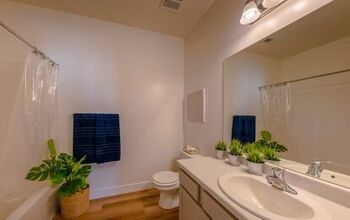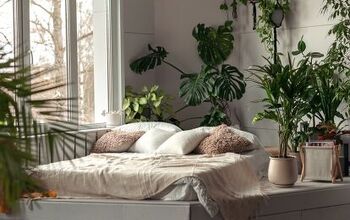How To Grow Plants Indoors Without Sunlight

There are many reasons to grow your plants inside, but it is usually due to lack of outdoor space. For those who reside in an apartment or somewhere without much yard or patio, this can be a great idea!
However, some plants need lots of sunlight. So, how exactly do you grow plants inside?
To grow plants inside, you will need the perfect setup. Make sure you have a grow tent, lights, and space set aside, and the plants you want to start growing.
By using artificial light, and the tents, you can mimic sunlight, making it so that your plants can grow. Additionally, you can set them in the window.
We’ve included everything you need to know about growing plants indoors within this article. Whether it’s houseplants, herbs or vegetables, we’ve got your back!
How Do You Start Growing Plants Inside?
To start growing plants indoors, you must first ensure you have the proper equipment. Below we have listed everything you will need.
Growing Tent
You have many different choices of grow tents to choose from. It makes sense that people will choose the larger grow tents, since each of your seedlings needs room to grow. It is not always the better decision to do that.
The fact that the interior of the majority of grow tents is lined with reflective material to better reflect light and regulate temperature is an added bonus.
Grow Lights
For tiny indoor herb and vegetable gardens, T5 fluorescence grow lights work nicely. These are perfect for small to larger grow tents that you use at home.
A larger area with HID (High-Intensity Discharge) grow bulbs would be more appropriate if you intend to harvest far more product than your family can use, possibly by selling something at your local markets.
Individual Pots
Use a different planting pot for each kind of seed or plant you intend to grow. Avoid growing many plants of the same kind in the same container. That will stifle the plants and slow their pace of growth.
Grow each vegetable and herb you intend to grow separately in a plant pot.
Start with a bigger pot than you anticipate needing, since plants develop healthier and more quickly when their roots are surrounded by oxygen.
Why Would You Want A Smaller Grow Tent?
You can cultivate both long-day and short-day plants in two tiny tents.
The plants in a grow tent receive the same quantity of light that is of the same intensity. Vegetables require six hours of sunlight daily, while herbs require four hours. Other plants will vary with sunlight time.
The required amount of light hours is greater for grow lights with a complete spectrum. Twelve to 16 hours a day are typically spent in full spectrum lighting.
In every situation, plants will require at least 8 hours of complete darkness in order for the photosynthetic stage to proceed as quickly and efficiently as possible. Herbs won’t require light for as long as vegetables do.
You can use two smaller grow tents—one for all the herbs you want to plant and another for your vegetables—instead of one larger one. When you have them, all you need to start the growth process are high-quality seeds.
What Are The Different Types Of Artificial Lighting?
You’ll need suspended tube fixtures positioned directly over your plants if you intend to undertake any major indoor gardening or start plants from seeds.
For typical houseplants, you can actually use any light or lighting fixture, as long as you select the bulbs correctly and position the lights where your plants may benefit most.
You can purchase specialized grow light kits that come with fixtures and reflectors.
For indoor plants, fluorescent lights are unquestionably the most convenient and affordable option. They are cool enough to place near plant foliage and available in tubes or small bulbs (CFL) that screw into standard light sockets.
Look for “full-spectrum” fluorescent lighting or use a combination of “cool” and “warm” bulbs, as generic fluorescent lighting has a higher proportion of blue wavelengths.
When in doubt, opt for “cool white” products because white light has all visible wavelengths. Place fluorescent bulbs just a few feet away from plant foliage for best results.
Halogen lights can also produce full-spectrum light, but they use more energy and produce a lot more heat than fluorescents.
Try utilizing a mixture of around one-third incandescent and two-thirds fluorescent by power if you wish to combine the two.
Another low-heat, cost-effective source of artificial light is LED lighting. Every LED light bulb is unique because the technology allows for so much customization, so make sure your lights generate the blues and reds that plants require.
The leaves of plants should be put further away from incandescent lights because they emit a lot of heat.
When trying to stimulate plants to blossom, incandescent bulbs can be used to smooth out the spectrum by supplementing fluorescent light with more red wavelengths.
You might wish to opt for horticultural LED grow lights rather than purchasing general-purpose bulbs, since they only provide the wavelengths that plants want to absorb.
Grow lights for plants are often sold in fluorescent tube form. They have all the wavelengths that blossoming plants, like African violets, require. However, other gardeners find that straightforward full-spectrum fluorescents perform just as well when beginning seeds or propagating hybrids.
How To Grow Your Indoor Plants Successfully
There is much more to having an indoor plant than just watering it and setting it on the window. Below, we will share with you how to ensure your plant fully blooms indoors.
Make Sure The Light Is In The Right Spot
The bulb light should first be positioned approximately an inch over the plant for your flowers and vegetables. But even then, it might be too near, so keep an eye on them.
When the leaves start to grow, look for browning along their edges. Brown leaves would be a sign that it’s getting too near and releasing too much heat, burning the plant.
Immediately increase the distance of the light in about half-inch increments until the brown stops. Start with an inch because that usually provides enough room.
Have Lots And Lots Of Space
It’s just a matter of placing your seedlings into the pots and having them ready to go inside your grow tent once you’ve set up the grow tent and figured out the spacing requirements.
For that, you’ll need good soil made for plants that require a lot of water, both of which herbs and uncooked vegetables do.
The finest potting soil for homegrown vegetables and herbs contains vermiculite, since it improves water and nutrient absorption, aerates the soil, and produces hardier plants.
Use a soil containing perlite as an alternative to vermiculite because it also improves plant absorption while being less aerating for the soils than a gardening mix containing vermiculite.
Water Your Plants
One tip to follow while growing indoor plants, including herbs and vegetables, is to wait until the soil is completely dry before watering. The temperature the plants are developed at will affect how quickly or slowly they move through the water. In general, a temperature of 60 to 70 degrees F is optimum.
Before adding water, you can either use a humidity meter to measure the plant’s water content or utilize your sense of touch. Water it if it feels dry.
What to look out for is a yellowing of the plant’s leaves, which indicates over-watering. If you keep doing that, the roots will eventually decay.
Use Fertilizer
Fertilizers aid in their growth, as they do for the majority of indoor plants. If they are edible plants, it stands to reason that you would prefer to use organic methods. You can only be sure you’re obtaining the best ingredients possible with this method.
Fish emulsion is the fertilizer of choice for indoor gardening of vegetables and plants. You may either create it yourself or purchase it already made and diluted in accordance with the directions on the packaging. It depends on the brand.
Because it has a higher proportion of nitrogen than other fertilizers, fish emulsion is used as a fertilizer for fresh food plants. It is, without a doubt, the most crucial nutrient that a plant needs in order to flourish.
The issue is that plants, especially those grown outside, cannot get nitrogen from the atmosphere. For the plant to take it, it needs to be in presence of inorganic, which fertilizers provide.
What Are Some Of The Best Plants To Grow Indoors?
If you don’t yet have any indoor plants that you own, that’s okay! Below, we’ve included a list of 5 of the best indoor plants that would take effort to kill.
Lucky Bamboo
Lucky bamboo, which is reputed to bring its owner good fortune, thrives in water-filled vases or jars or in pots filled with regular potting soil. For this nearly durable plant, low light is ideal.
Lucky bamboo, however, is delicate to chlorine and other contaminants present in ordinary tap water. Use bottled or distilled water to get around this issue, or leave liquid out for 24 hours and the contaminants will evaporate.
Chinese Evergreen
Chinese evergreen is a hardy plant that can withstand some neglect. Beautiful, white blooms that resemble calla lilies are produced by mature plants.
The leaves of the Chinese evergreen will be scorched by excessive light, thus, it does best in dim light or under a normal bulb. Pick a variegated species with darker leaves because those with cream or silver marks on them need a little more light.
Monstera
The monstera plant, also known as the Swiss cheese plant, impresses with large, robust, heart-shaped leaves that, as the plant ages, acquire intriguing holes or splits.
This plant can tolerate any level of light, but because it loves to climb, be careful to offer a trellis or pole covered in moss.
Cast Iron Plant
This sluggish plant is incredibly hardy and doesn’t like a lot of hassle; water-logging and frequent repotting can both be harmful to the plant.
Although the cast iron plant may grow in very low light, it won’t thrive in total darkness, as with most shade-loving species.
ZZ Plant
Be wary of the ZZ plant’s glossy, waxy leaves, which are deceptive because they can tolerate very little natural light and are as strong as nails, and almost impossible to kill. It can also survive in a dry climate and grows well with infrequent watering.
Related Guides:

Heather is a passionate writer who loves anything DIY. Growing up, she learned everything from home repairs to design, and wants to share her tips with you. When she's not writing, she's usually hiking or searching for her next DIY project.
More by Heather Robbins



























